List of amphibians of Bulgaria
Bulgaria is a country in southeastern Europe situated entirely in the Balkan peninsula. Bulgaria is inhabited by 22 amphibian species, which makes the amphibians the least diverse class of vertebrates in the country.[1] They include nine species of newts and salamanders from a single family, Salamandridae, as well as 13 frog and toad species from five families—Bombinatoridae, Bufonidae, Hylidae, Pelobatidae and Ranidae. The most recently classified species are the northern crested newt, identified in 2005,[2] and the Macedonian crested newt, identified in 2007.[3] In 2017 genetic studies suggested that the smooth newt was a species complex and was split in six species, of which three are fount in Bulgaria—the smooth newt sensu lato, the Greek smooth newt and the Schmidtler's smooth newt.[4] Some of the most common species include the European green toad, yellow-bellied toad, and marsh frog.
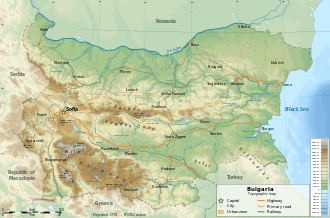
The foundations of Bulgarian herpetology (the study of amphibians and reptiles) were laid in the end of the 19th century by the teacher Vasil Kovachev, who published a number of articles on the subject and the 1912 book Herpetologic Fauna of Bulgaria.[5] In the 1930s and 1940s zoologist Ivan Buresh and his associate Yordan Tsonkov conducted in-depth research on the diversity and distribution of the amphibian and reptile species in the country. In the second half of the 20th century the leading Bulgarian herpetologist was Dr. Vladimir Beshkov.[5]
Bulgaria provides various habitats for amphibians. The country falls within six terrestrial ecoregions of the Palearctic realm: Balkan mixed forests, Rodope montane mixed forests, Euxine-Colchic deciduous forests, Aegean and Western Turkey sclerophyllous and mixed forests, East European forest steppe and Pontic–Caspian steppe.[6] Bulgaria has varied topography. From north to south the main geomorphological regions are the Danubian Plain, the Balkan Mountains, the Sub-Balkan valleys, the Rila–Rhodope massif to the south-west, the Upper Thracian Plain and the Strandzha mountains to the south-east. The country has a dense network of rivers but with the notable exception of the Danube, they are mostly short and with low water flow.[7] The average annual precipitation is 670 mm; the rainfall is lower in the lowlands and higher in the mountains. The driest region is Dobrudzha in the north-eastern part of the Danubian Plain (450 mm), while the highest rainfall has been measured in the upper valley of the river Ogosta in the western Balkan Mountains (2293 mm).[8]
List of species
Order Caudata
Family Salamandridae
Salamandridae, or true salamanders, are a family of terrestrial and aquatic salamanders, mostly distributed in Asia and Europe, although some species are found in North Africa and North America. Most species have slightly toxic skin secretions and many develop dorsal body and tail fins when they return to an aquatic stage. There are 109 species in 21 genera; of these, nine species in four genera are found in Bulgaria.[9]
| Species | Common name | Distribution | Status[a] | Image |
|---|---|---|---|---|
| Lissotriton graecus | Greek smooth newt | Sandanski-Petrich Valley and Belastisa mountain, south-westernmost Bulgaria[4] | 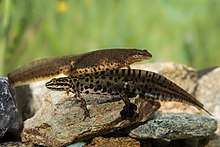 | |
| Lissotriton schmidtleri | Schmidtler's smooth newt | Found in south-eastern Bulgaria, up to 1500 m altitude[4] | ||
| Lissotriton vulgaris | smooth newt | Found in the whole country, up to 1500 m altitude;[10] a 2017 determined that the smooth newt was a species complex and was split in six species; the smooth newt sensu lato inhabits the north and west of the country[4] |  | |
| Mesotriton alpestris | Alpine newt | Most common in the Rila and western Rhodope Mountains; isolated populations in the western Balkan Mountains, central Sredna Gora and Osogovo[1] | 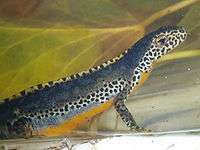 | |
| Salamandra salamandra | fire salamander | Moist wooded areas in the mountains, mostly absent from the Danubian Plain and the Upper Thracian Plain[13] |  | |
| Triturus cristatus | northern crested newt | First discovered in Bulgaria in 2005; found in the western Balkan Mountains near Vratsa which is its southernmost locality[2][15][16] |  | |
| Triturus dobrogicus | Danube crested newt | Occurs in the Danube river and the lower course of its tributaries[18] | 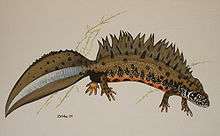 | |
| Triturus ivanbureschi | Balkan-Anatolian crested newt | Common in the country up to 1500 m altitude; absent from the Danube river and the lower course of its tributaries[20] | ||
| Triturus macedonicus | Macedonian crested newt | Slavyanka mountain in south-western Bulgaria[3] | 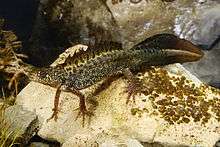 | |
Order Anura
Family Bombinatoridae
Bombinatoridae are an Old World toad family often referred to as fire-bellied toads because of their brightly coloured ventral sides which demonstrate their high toxicity. It includes ten species in two genera, Barbourula and Bombina, both of which have flattened bodies, of which two species from genus Bombina occur in Bulgaria.[21]
| Species | Common name | Distribution | Status | Image |
|---|---|---|---|---|
| Bombina bombina | European fire-bellied toad | Found in the lowlands of the country, up to 250 m altitude: the Danube and Upper Thracian Plains and the Black Sea Coast[22] | _tight_crop.jpg) | |
| Bombina variegata | yellow-bellied toad | Common species in the lower mountains, up to 2000 m altitude (in Pirin and the Balkan Mountains)[24] |  | |
Family Bufonidae
Bufonidae are a family of toads native to every continent except Australia and Antarctica. Bufonidae include the typical toads with shortened forelimbs, hindlimbs used for walking or hopping, dry warty skin, and parotoid glands behind eyes. The family contains 590 species in 50 genera, of which 2 species from genus Bufo are found in Bulgaria.[26]
| Species | Common name | Distribution | Status | Image |
|---|---|---|---|---|
| Bufo bufo | common toad | Found all over the country, up to 1300 m altitude, with the exception of Pirin, where it has been recorded at 1960 m[27] | 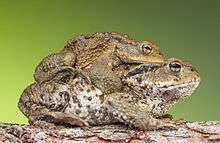 | |
| Bufo viridis | European green toad | Found all over the country, up to 1200 m altitude; recorded in Rila at an altitude of 2000 m[29] |  | |
Family Hylidae
Hylidae or tree frogs are the most diverse amphibian family with 951 species in 51 genera, and worldwide distribution. Most species inhabit tropical areas with warm and humid climate, especially the Neotropics. Hylids range from small to large in size and usually have distinct adhesive toe discs that contain a cartilage offsetting the terminal phalanx, which aids in climbing. The only genus found in Europe is Hyla, with 6 species out of 37 worldwide, and one in Bulgaria.[31]
| Species | Common name | Distribution | Status | Image |
|---|---|---|---|---|
| Hyla arborea | European tree frog | Found all over the country, up to 1300 m altitude; recorded in Rila at an altitude of 2300 m[32] |  | |
Family Pelobatidae
Pelobatidae, also known as spadefoot toads, are a small family of frogs with one genus and four species spread in Europe, Western Asia and North-western Africa. They have short legs, stocky bodies with vertical pupils and produce an odour similar to garlic, hence their name in Bulgarian is чесновица (chesnovica), 'garlic toad'. Two of the four species inhabit the country.[34]
| Species | Common name | Distribution | Status | Image |
|---|---|---|---|---|
| Pelobates fuscus | common spadefoot | Found in the areas along the Danube river, the northernmost Black Sea coast, as well as in isolated populations in Sofia Valley[35] |  | |
| Pelobates syriacus | eastern spadefoot toad | Found in the areas along the Danube river, the whole Black Sea coast, the Upper Thracian Plain and the southern Struma valley[35] | 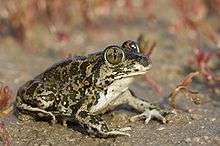 | |
Family Ranidae
Ranidae are a widespread family also known as true frogs. They have generalized frog body plans and a generalized aquatic tadpole stage. The family includes 379 species in 14 genera, of which six species in two genera occur in Bulgaria.[34]
| Species | Common name | Distribution | Status | Image |
|---|---|---|---|---|
| Pelophylax kl. esculentus | edible frog | Found along the Danube river and the lower course of its tributaries, as well as along the Black Sea coast[38] |  | |
| Pelophylax lessonae | pool frog | Westernmost areas along the Bulgarian Danube bank[40] | ||
| Pelophylax ridibundus | marsh frog | Found all over the country, up to 1300 m altitude; recorded in Belasitsa at an altitude of 2000 m[42] |  | |
| Rana dalmatina | agile frog | Found all over the country, up to 1200 m altitude, with singular records up to 2000 m[44] | 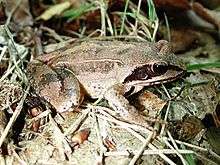 | |
| Rana graeca | Greek stream frog | Occurs in south-western Bulgaria[46] | 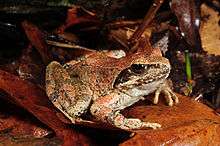 | |
| Rana temporaria | common frog | Found mostly in the mountains, between 1000 and 2000 m altitude: Balkan Mountains, Rila, Pirin, Vitosha, Osogovo, Rhodope Mountains[48] | .jpg) | |
See also
Footnotes
Notes
^ a: Conservation status at a world level (not exclusive to Bulgaria) of the species according to the IUCN Red List: Conservation status - IUCN Red List of Threatened Species:
- EX - Extinct, EW - Extinct in the wild
- CR - Critically endangered, EN - Endangered, VU - Vulnerable
- NT - Near threatened, LC - Least concern
- DD - Data deficient, NE - Not evaluated
Citations
- Biserkov 2007, p. 34
- Biserkov 2007, p. 37
- Naumov, Borislav; Tzankov, Nikolay (2008). "First record of Triturus macedonicus (Karaman, 1922) (Amphibia: Salamandridae) in Bulgaria" (PDF). Historia Naturalis Bulgarica. 19: 111–114. Archived from the original (PDF) on 14 July 2014. Retrieved 13 July 2015.
- Wielstra, B.; Canestrelli, D.; Cvijanović, M.; et al. (2018). "The distributions of the six species constituting the smooth newt species complex (Lissotriton vulgaris sensu lato and L. montandoni) – an addition to the New Atlas of Amphibians and Reptiles of Europe" (PDF). Amphibia-Reptilia. 39: 252–259. Archived from the original (PDF) on 28 April 2019.
- Biserkov 2007, p. 28
- "Ecoregions of Bulgaria". The Encyclopedia of Earth. Archived from the original on 6 July 2015. Retrieved 13 July 2015.
- Дончев (Donchev) & Каракашев (Karakashev) 2004, p. 68
- Дончев (Donchev) & Каракашев (Karakashev) 2004, pp. 57–58
- "Salamandridae". AmphibiaWeb. Archived from the original on 1 June 2016. Retrieved 18 March 2015.
- Biserkov 2007, p. 33
- Arntzen, J.W.; et al. (2009). "Lissotriton vulgaris". IUCN Red List of Threatened Species. 2009. Retrieved 13 March 2015.CS1 maint: ref=harv (link)
- Arntzen, J.W.; et al. (2009). "Mesotriton alpestris". IUCN Red List of Threatened Species. 2009. Retrieved 13 March 2015.CS1 maint: ref=harv (link)
- Biserkov 2007, p. 32
- Arntzen, J.W.; et al. (2009). "Salamandra salamandra". IUCN Red List of Threatened Species. 2009. Retrieved 13 March 2015.CS1 maint: ref=harv (link)
- Tzankov, Nikolay; Stoyanov, Andrei (2008). Triturus cristatus (Laurenti, 1768): a new species for Bulgaria from its southernmost localities. ISSN 0036-3375.
- "Triturus cristatus". AmphibiaWeb. Retrieved 13 March 2015.
- Arntzen, J.W.; et al. (2009). "Triturus cristatus". IUCN Red List of Threatened Species. 2009. Retrieved 13 March 2015.CS1 maint: ref=harv (link)
- Biserkov 2007, p. 38
- Arntzen, J.W.; et al. (2009). "Triturus dobrogicus". IUCN Red List of Threatened Species. 2009. Retrieved 13 March 2015.CS1 maint: ref=harv (link)
- Biserkov 2007, p. 36
- "Bombinatoridae". AmphibiaWeb. Archived from the original on 8 March 2015. Retrieved 18 March 2015.
- Biserkov 2007, p. 45
- Arntzen, J.W.; et al. (2009). "Bombina bombina". IUCN Red List of Threatened Species. 2009. Retrieved 13 March 2015.CS1 maint: ref=harv (link)
- Biserkov 2007, p. 46
- Arntzen, J.W.; et al. (2009). "Bombina variegata". IUCN Red List of Threatened Species. 2009. Retrieved 13 March 2015.CS1 maint: ref=harv (link)
- "Bufonidae". AmphibiaWeb. Archived from the original on 30 March 2015. Retrieved 18 March 2015.
- Biserkov 2007, p. 51
- Arntzen, J.W.; et al. (2009). "Bufo bufo". IUCN Red List of Threatened Species. 2009. Retrieved 13 March 2015.CS1 maint: ref=harv (link)
- Biserkov 2007, pp. 52–53
- Arntzen, J.W.; et al. (2009). "Bufo viridis". IUCN Red List of Threatened Species. 2009. Retrieved 13 March 2015.CS1 maint: ref=harv (link)
- "Hylidae". AmphibiaWeb. Archived from the original on 13 March 2015. Retrieved 18 March 2015.
- Biserkov 2007, pp. 54
- Arntzen, J.W.; et al. (2009). "Hyla arborea". IUCN Red List of Threatened Species. 2009. Retrieved 13 March 2015.CS1 maint: ref=harv (link)
- "Pelobatidae". AmphibiaWeb. Archived from the original on 23 March 2016. Retrieved 18 March 2015.
- Biserkov 2007, p. 48
- Arntzen, J.W.; et al. (2009). "Pelobates fuscus". IUCN Red List of Threatened Species. 2009. Retrieved 13 March 2015.CS1 maint: ref=harv (link)
- Arntzen, J.W.; et al. (2009). "Bufo viridis". IUCN Red List of Threatened Species. 2009. Retrieved 13 March 2015.CS1 maint: ref=harv (link)
- Biserkov 2007, p. 60
- Arntzen, J.W.; et al. (2009). "Pelophylax kl. esculentus". IUCN Red List of Threatened Species. 2009. Retrieved 13 March 2015.CS1 maint: ref=harv (link)
- Biserkov 2007, p. 62
- Arntzen, J.W.; et al. (2009). "Pelophylax lessonae". IUCN Red List of Threatened Species. 2009. Retrieved 13 March 2015.CS1 maint: ref=harv (link)
- Biserkov 2007, p. 59
- Arntzen, J.W.; et al. (2009). "Pelophylax ridibundus". IUCN Red List of Threatened Species. 2009. Retrieved 13 March 2015.CS1 maint: ref=harv (link)
- Biserkov 2007, p. 56
- Arntzen, J.W.; et al. (2009). "Rana dalmatina". IUCN Red List of Threatened Species. 2009. Retrieved 13 March 2015.CS1 maint: ref=harv (link)
- Biserkov 2007, p. 57
- Arntzen, J.W.; et al. (2009). "Rana graeca". IUCN Red List of Threatened Species. 2009. Retrieved 13 March 2015.CS1 maint: ref=harv (link)
- Biserkov 2007, p. 58
- Arntzen, J.W.; et al. (2009). "Rana temporaria". IUCN Red List of Threatened Species. 2009. Retrieved 13 March 2015.CS1 maint: ref=harv (link)
References
Sources
- Biserkov, V. (2007). Определител на земноводните и влечугите в България (A Field Guide to Amphibians and Reptiles of Bulgaria) (in Bulgarian). София (Sofia): Зелени Балкани (Green Balkans). ISBN 978-954-9433-07-4.CS1 maint: ref=harv (link)
- Beshkov, Vladimir; Nanev, Krastyo (2002). Земноводни и влечуги в България (Amphibians and Reptiles of Bulgaria) (in Bulgarian). София (Sofia): Пенсофт (Pensoft). ISBN 978-954-642-147-0.CS1 maint: ref=harv (link)
- Дончев (Donchev), Дончо (Doncho); Каракашев (Karakashev), Христо (Hristo) (2004). Теми по физическа и социално-икономическа география на България (Topics on Physical and Social-Economic Geography of Bulgaria) (in Bulgarian). София (Sofia): Ciela. ISBN 978-954-649-717-8.CS1 maint: ref=harv (link)
External links
- Naumov, B.; Stanchev, M. "Amphibians and reptiles of Bulgaria and the Balkan Peninsula" (in Bulgarian). An online edition of the Bulgarian Herpetological Society. Archived from the original on 27 December 2003. Retrieved 13 March 2015.
- Mazzei, P. "Amphibians and reptiles of Europe". Retrieved 13 March 2015.
- "AmphibiaWeb". Retrieved 13 March 2015.
- "The IUCN List of Threatened Species". Retrieved 13 March 2015.
